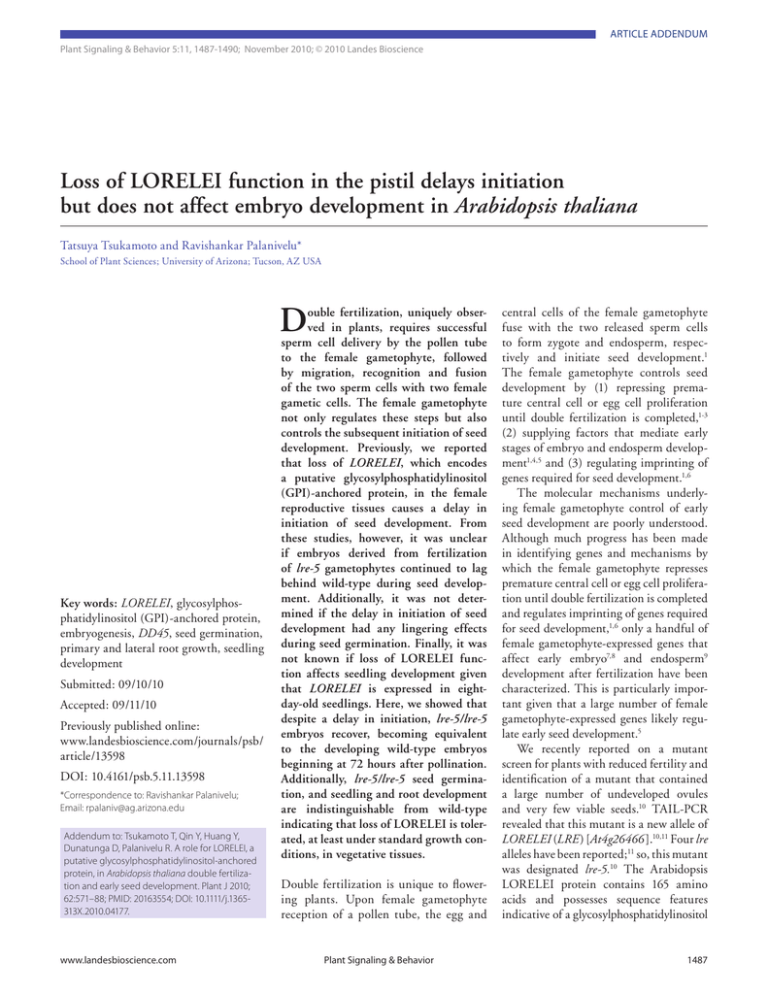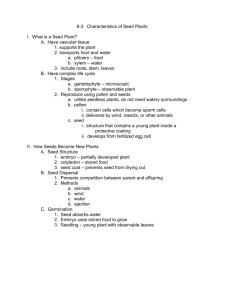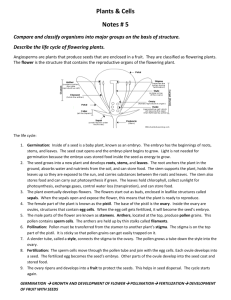D Loss of LORELEI function in the pistil delays initiation Arabidopsis thaliana
advertisement

ARTICLE ADDENDUM ARTICLE ADDENDUM Plant Signaling & Behavior 5:11, 1487-1490; November 2010; © 2010 Landes Bioscience Loss of LORELEI function in the pistil delays initiation but does not affect embryo development in Arabidopsis thaliana Tatsuya Tsukamoto and Ravishankar Palanivelu* School of Plant Sciences; University of Arizona; Tucson, AZ USA D Key words: LORELEI, glycosylphosphatidylinositol (GPI)-anchored protein, embryogenesis, DD45, seed germination, primary and lateral root growth, seedling development Submitted: 09/10/10 Accepted: 09/11/10 Previously published online: www.landesbioscience.com/journals/psb/ article/13598 DOI: 10.4161/psb.5.11.13598 *Correspondence to: Ravishankar Palanivelu; Email: rpalaniv@ag.arizona.edu Addendum to: Tsukamoto T, Qin Y, Huang Y, Dunatunga D, Palanivelu R. A role for LORELEI, a putative glycosylphosphatidylinositol-anchored protein, in Arabidopsis thaliana double fertilization and early seed development. Plant J 2010; 62:571–88; PMID: 20163554; DOI: 10.1111/j.1365313X.2010.04177. www.landesbioscience.com ouble fertilization, uniquely observed in plants, requires successful sperm cell delivery by the pollen tube to the female gametophyte, followed by migration, recognition and fusion of the two sperm cells with two female gametic cells. The female gametophyte not only regulates these steps but also controls the subsequent initiation of seed development. Previously, we reported that loss of LORELEI, which encodes a putative glycosylphosphatidylinositol (GPI)-anchored protein, in the female reproductive tissues causes a delay in initiation of seed development. From these studies, however, it was unclear if embryos derived from fertilization of lre-5 gametophytes continued to lag behind wild-type during seed development. Additionally, it was not determined if the delay in initiation of seed development had any lingering effects during seed germination. Finally, it was not known if loss of LORELEI function affects seedling development given that LORELEI is expressed in eightday-old seedlings. Here, we showed that despite a delay in initiation, lre-5/lre-5 embryos recover, becoming equivalent to the developing wild-type embryos beginning at 72 hours after pollination. Additionally, lre-5/lre-5 seed germination, and seedling and root development are indistinguishable from wild-type indicating that loss of LORELEI is tolerated, at least under standard growth conditions, in vegetative tissues. Double fertilization is unique to flowering plants. Upon female gametophyte reception of a pollen tube, the egg and Plant Signaling & Behavior central cells of the female gametophyte fuse with the two released sperm cells to form zygote and endosperm, respectively and initiate seed development.1 The female gametophyte controls seed development by (1) repressing premature central cell or egg cell proliferation until double fertilization is completed,1-3 (2) supplying factors that mediate early stages of embryo and endosperm development1,4,5 and (3) regulating imprinting of genes required for seed development.1,6 The molecular mechanisms underlying female gametophyte control of early seed development are poorly understood. Although much progress has been made in identifying genes and mechanisms by which the female gametophyte represses premature central cell or egg cell proliferation until double fertilization is completed and regulates imprinting of genes required for seed development,1,6 only a handful of female gametophyte-expressed genes that affect early embryo7,8 and endosperm9 development after fertilization have been characterized. This is particularly important given that a large number of female gametophyte-expressed genes likely regulate early seed development.5 We recently reported on a mutant screen for plants with reduced fertility and identification of a mutant that contained a large number of undeveloped ovules and very few viable seeds.10 TAIL-PCR revealed that this mutant is a new allele of LORELEI (LRE) [At4g26466 ].10,11 Four lre alleles have been reported;11 so, this mutant was designated lre-5.10 The Arabidopsis LORELEI protein contains 165 amino acids and possesses sequence features indicative of a glycosylphosphatidylinositol 1487 loss of LORELEI function in the female reproductive tissues causes the delay in initiation of seed development. From these studies, however, it was unclear if embryos derived from fertilization of lre-5 gametophytes continued to lag behind wild-type during seed development. Additionally, it has not been determined if the delay in initiation of seed development had any lingering effects during seed germination. Finally, it is not known if loss of LORELEI function affects seedling development given that LORELEI is expressed in eight-day-old seedlings.10 In this report, we used an embryo-expressed marker (DD45:GFP)14 to monitor lre-5/lre-5 embryos during seed development. Additionally, we analyzed seed germination, seedling growth and root development in lre-5/lre-5 plants to examine the effects of loss of LORELEI on these aspects of plant development. Figure 1. Analysis of embryo development in self-pollinated pistils. Fluorescent images of DD45:GFP expression in embryos in developing seeds in manually self-pollinated wild-type (A–D) or lre-5/lre-5 pistils (E–H) carrying the DD45:GFP/DD45:GFP transgene and observed at the indicated HAP. In (D and H), the DD45:GFP expression in nuclei is no longer clearly visible due to thickening of the seed coat by 72 HAP. AC, MC and BC, apical, middle and basal cells, respectively, in a proembryo; O, octant stage of apical cell division; H, hypophysis; SC, suspensor cells; EP, embryo proper. Scale bars, 50 μm. (GPI)-anchor containing cell surface protein. GPI-anchors serve as an alternative to transmembrane domains for anchoring proteins in cell membranes and GPIanchored proteins participate in many functions including cell-cell signaling.12 Loss of LORELEI Function in the Female Reproductive Tissues Results in a Delay of Seed Development Initiation Most lre-5 female gametophytes in lre-5/ lre-5 pistils do not allow pollen tube reception; consequently, these ovules remain unfertilized.10 The lre-5 mutation is partially-penetrant and female gametophytespecific; consequently, a majority of the lre-5 female gametophytes (~73%) do not undergo normal pollen tube reception. In those that do, we demonstrated that initiation of seed development is delayed and that this delay originates after lre-5/lre-5 ovules complete double fertilization.10 We identified this delay by pollinating GRP23:GUS pollen on lre-5/lre-5 pistils and monitoring 1488 GRP23:GUS expression in lre-5/lre-5 ovules after fertilization. GRP23:GUS is expressed not only in pollen tubes but also in developing seeds from the zygote and endosperm nuclear proliferation stages.13 We reasoned that in lre-5/lre-5 pistils, the ~27% of ovules that induce pollen tube reception10 would allow monitoring of post-fertilization GRP23:GUS expression and seed development. By 16 hours after pollination (HAP), 27.1% of all lre-5/lre-5 ovules that induced pollen tube reception did not show GRP23:GUS expression in proliferating endosperm nuclei like that in wild type.10 Even by 24 HAP, 25.4% of all ovules continued to show GUS staining that is only indicative of pollen tube reception completion and lacked expression elsewhere in the embryo sac, indicating a delay in the initiation of early seed development. Importantly, the delay in initiation of seed development was not rescued by a wild-type LORELEI delivered through pollen (note that the LORELEI locus is wild-type in GRP23:GUS pollen). Together, these results suggested that Plant Signaling & Behavior Despite a Delay in Initiation lre-5/lre-5 Embryos Recover and Complete Embryo Development To examine the role of LORELEI in embryo development, we crossed lre-5/ lre-5 pollen onto pistils of DD45:GFP/ DD45:GFP plants14 and from the F2 progeny identified plants that are homozygous for both lre-5 and the DD45:GFP transgene. We examined DD45:GFP expression from 36 HAP onwards in developing seeds within manually self-pollinated lre-5/ lre-5, DD45:GFP/DD45:GFP siliques. Ovules closest to the stigma receive pollen tubes approximately six hours before those near the pedicle;15 therefore, only 15 rows of ovules from the stigma end were analyzed. In every wild-type seed, by 36HAP, DD45:GFP expression was observed in the four-celled proembryo containing two apical cells, a middle and a basal cell (Fig. 1A). By 48 HAP, DD45:GFP expression was detected in the apical cells (octant-stage of cell division), hypophysis, suspensor and basal cells (Fig. 1B). Subsequently, by 60 HAP and 72 HAP, the embryo proper increases in size concomitant with an increase in suspensor length (Fig. 1C and D). Unlike in wild-type, there was a delay in lre-5/lre-5 embryo development at the earlier time points; by 36 HAP, the Volume 5 Issue 11 DD45:GFP expression was detected in the apical and basal cells of an asymmetricallydivided zygote (Fig. 1E). By 48 HAP, DD45:GFP expression was detected in the apical and basal cells and in the two suspensor cells formed by the middle cell undergoing a transverse division (Fig. 1F). The lag in embryo development is also noticeable by 60 HAP as the apical cells in the mutant are only at the octant stage (Fig. 1G). However, by 72 HAP, the lre-5/ lre-5 embryos begin to reach similar stage of development as wild-type (compare size of embryo proper in Fig. 1D and H). Those lre-5/lre-5 embryos that have not caught up with wild-type embryos by 72 HAP, similar to those reported in Figure 4 of our previous report,10 recover at a later time point in seed development (not shown). These results suggest that lre-5/lre-5 embryos recover and overcome the delay in initiation of embryo development beginning from 72 HAP. The delay in embryo development phenotype reported here will also make it easy to characterize this phenotype in future experiments, as monitoring DD45:GFP expression in self-pollinated lre-5/lre-5 pistils negates the need to cross the reporter gene-carrying pollen (such as GRP23:GUS) each time onto lre-5/lre-5 pistils to detect this phenotype.10 The lre-5/lre-5 Plants Do Not Exhibit any Detectable Defects during Seedling and Root Development Previously we reported that in vegetative tissues, LORELEI is primarily expressed in eight-day-old seedlings.10 Yet, whether complete loss of LORELEI expression (lre-5 is a null allele10) resulted in any defects during seedling and root development was not investigated. Additionally, it was not examined if the delay in seed development initiation caused by the loss of LORELEI function in pistils had any lingering effects during seed germination, seedling and root development. We determined the germination of stratified, wild-type and lre-5/lre-5 seeds, eight days after plating on 1x MS growth medium; the rate of seed germination was nearly identical in both wild-type and lre-5/lre-5 (Fig. 2A–C). The cotyledon leaves in lre-5/lre-5 seedlings did not show any obvious defects and were www.landesbioscience.com Figure 2. Analysis of germination and root development in seedlings. Photographs of germinated wild-type (A) and lre-5/lre-5 (B) seedlings. Images in (A and B) were acquired eight days after plating the seeds on 1x MS medium (supplemented with 2% sucrose) and growing under continuous light at 21°C. The seeds used in this experiment were considered stratified as they were stored, since harvest, in 4°C with desiccant. (C) A table summarizing germination of wild-type and lre-5/lre-5 seedlings. Photographs of root development, eight days (D) or 11 days (E) after plating six wild-type and six lre-5/lre-5 seeds on the left and right side of the plate containing 1/2x MS medium (supplemented with 2% sucrose and 2.5 mM MES), respectively and growing under continuous light at 21°C. The seeds used in this experiment were considered stratified as they were stored, since harvest, in 4°C with desiccant. The area of each grid in the square plate is 13 mm2. (F) A table summarizing primary root length and number of lateral roots in wild-type and lre-5/lre-5 plants; n, total number of seedlings analyzed in this experiment. virtually indistinguishable from wild-type (not shown). The near uniformity and rate of lre-5/lre-5 seed germination that is on par with wild-type is also consistent with the observation that nearly all lre-5/lre-5 embryos recover and become equivalent to Plant Signaling & Behavior wild-type embryos during embryo development (Fig. 1). We also examined root growth by plating stratified seeds on 1/2x MS medium and incubating the plates vertically in a growth chamber. The primary root growth in lre-5/lre-5 seedlings, both 1489 8- and 11-days after plating, was indistinguishable from wild type (Fig. 2D–F). The number of lateral roots in 11-day-old lre-5/lre-5 seedlings was also similar to wild type (Fig. 2F). These results indicate that LORELEI is not essential for seedling and root development in 11-day-old seedlings, at least in the plant growth conditions used in this experiment. Acknowledgements We thank Dr. Gary Drews for DD45:GFP seeds; Dr. Ramin Yadegari for providing access to the fluorescent microscope (Fig. 1); Shea Monihan and Dr. Karen Schumaker for assistance with root growth experiments (Fig. 2). We thank Dr. Jennifer Mach for critical reading of the manuscript. This work was supported by a NSF grant to R.P. (IOS-0723421). 1490 References 1. Yadegari R, Drews GN. Female gametophyte development. Plant Cell 2004; 16:133-41. 2. Berger F, Grini PE, Schnittger A. Endosperm: an integrator of seed growth and development. Curr Opin Plant Biol 2006; 9:664-70. 3. Pien S, Grossniklaus U. Polycomb group and trithorax group proteins in Arabidopsis. Biochim Biophys Acta 2007; 1769:375-82. 4. Grini PE, Jurgens G, Hulskamp M. Embryo and endosperm development is disrupted in the female gametophytic capulet mutants of Arabidopsis. Genetics 2002; 162:1911-25. 5. Pagnussat GC, Yu HJ, Ngo QA, Rajani S, Mayalagu S, Johnson CS, et al. Genetic and molecular identification of genes required for female gametophyte development and function in Arabidopsis. Development 2005; 132:603-14. 6. Baroux C, Pien S, Grossniklaus U. Chromatin modification and remodeling during early seed development. Curr Opin Genet Dev 2007; 17:473-9. 7. Evans MM, Kermicle JL. Interaction between maternal effect and zygotic effect mutations during maize seed development. Genetics 2001; 159:303-15. 8. Springer PS, Holding DR, Groover A, Yordan C, Martienssen RA. The essential Mcm7 protein PROLIFERA is localized to the nucleus of dividing cells during the G1 phase and is required maternally for early Arabidopsis development. Development 2000; 127:1815-22. Plant Signaling & Behavior 9. Andreuzza S, Li J, Guitton AE, Faure JE, Casanova S, Park JS, et al. DNA LIGASE I exerts a maternal effect on seed development in Arabidopsis thaliana. Development 2010; 137:73-81. 10. Tsukamoto T, Qin Y, Huang Y, Dunatunga D, Palanivelu R. A role for LORELEI, a putative glycosylphosphatidylinositol-anchored protein, in Arabidopsis thaliana double fertilization and early seed development. Plant J 2010; 62:571-88. 11. Capron A, Gourgues M, Neiva LS, Faure JE, Berger F, Pagnussat G, et al. Maternal control of malegamete delivery in Arabidopsis involves a putative GPI-anchored protein encoded by the LORELEI gene. Plant Cell 2008; 20:3038-49. 12. Schultz C, Gilson P, Oxley D, Youl J, Bacic A. GPIanchors on arabinogalactan-proteins: implications for signaling in plants. Trends Plant Sci 1998; 3:426-31. 13. Ding YH, Liu NY, Tang ZS, Liu J, Yang WC. Arabidopsis GLUTAMINE-RICH PROTEIN23 is essential for early embryogenesis and encodes a novel nuclear PPR motif protein that interacts with RNA polymerase II subunit III. Plant Cell 2006; 18:815-30. 14. Steffen JG, Kang IH, Macfarlane J, Drews GN. Identification of genes expressed in the Arabidopsis female gametophyte. Plant J 2007; 51:281-92. 15. Sandaklie-Nikolova L, Palanivelu R, King EJ, Copenhaver GP, Drews GN. Synergid cell death in Arabidopsis is triggered following direct interaction with the pollen tube. Plant Physiol 2007; 144:1753-62. Volume 5 Issue 11





